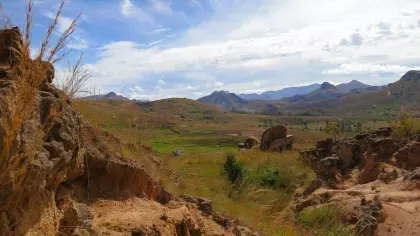Madagascar yam conservation for livelihoods
Conserving Madagascar’s edible wild yams through cultivation to enhance livelihoods and food security.

Maintaining a sustainable food supply in Madagascar for low-income families in the face of climate change.
Madagascar’s population relies on wild yams for food to supplement small, seasonal and unreliable staple crops. Of Madagascar's 40 yam species, 33 are endemic, but at least 12 are threatened by overexploitation, habitat loss and climate change. Many of these threatened species are endemic to small areas of the country.
The World Bank ranks Madagascar at 207 out of 213 countries by GNI (Gross National Income) per capita. This situation is set to worsen as famine occurs regularly in Madagascar, and food production is predicted to decrease with climate change. One of the benefits of relying on yams is that they occur in all climate zones, their diversity providing resilience against environmental change.
Winged yam Dioscorea alata, originally from Asia, is grown on a small scale in gardens. Kew research has shown that when cultivated agriculturally it improves livelihoods of local people and reduces pressure on wild species.
This project utilises both D. alata and major endemic, wild, edible species to scale up yam cultivation and sustainable harvesting:
- recognising the role of farmers in conserving yam diversity
- establishing a national system to conserve yams and associated bio-cultural knowledge
- providing stakeholders with access to genetic material (seed banks and living collections)
Location, methods and approaches
We are working in Antsiranana Province in northern Madagascar and Fianarantsoa in the east:
- surveying and monitoring populations of wild yams to generate and update IUCN conservation status assessments
- cultivating wild yams for their conservation, food security and to evaluate their potential as novel crops
- cultivating D. alata to increase food production in target communities and reduce harvesting pressure on wild yam species
- developing conservation plans with target communities
- collecting seeds of wild yams and undertaking germination tests
Livelihoods and food security
The project will improve livelihoods and food security, through enhancing the agrobiodiversity of yams, and reinforce forest conservation, through demonstrating the natural capital of sustainably managed populations.
Kew’s role in the project
Kew is leading the project, providing institutional management and administration, as well as technical steering and training in key areas such as yam taxonomy and ecology, GIS, niche modelling and population and socio-economic surveys.
Objectives
- To improve knowledge and awareness of wild and cultivated yams in Madagascar.
- Cultivate native yam species and winged yam cultivars.
- Conservation management.
- Implement ex situ conservation.
- Improve household nutrition and income indicators.
- A national strategy for wild yams in Madagascar to complement that for cultivated yams.
- Manuals, videos and workshops made available, providing information on native species and cultigens.
- 'Living gene bank' collections in communities and regionally in Madagascar, especially for the most threatened species.
- Banking of seeds of all wild species at Silo National des Graines Forestieres in Madagascar and Kew.
- Improved nutrition and project indicators in the project communities.
- Kew Madagascar Conservation Centre, Antananarivo
- Feedback Madagascar /Ny Tanintsika, Antananarivo/Fianarantsoa
- Silo National des Graines Forestieres, Antananarivo
Darwin Initiative (Ref: 22-005)
The April Trust
Wilkin, P., Kennerley, J.A., Rajaonah, M.T. et al. (2017).
A new species of critically endangered edible yam endemic to northern Madagascar, Dioscorea irodensis (Dioscoreaceae) and its conservation.
Kew Bulletin 72, 15.
Wilkin, P., Hladik, A., Weber, O., Hladik, C. M. & Jeannoda, V. (2009)
Dioscorea orangeana(Dioscoreaceae), a new and threatened species of edible yam from northern Madagascar
Kew Bulletin 64: 461–468
Wilkin, P., Hladik, A., Jeannoda, V. & Weber, O. (2009)
The threatened edible yams of the Dioscorea sambiranensis R.Knuth species complex (Dioscoreaceae): a new species and subspecies
Adansonia 31: 249–266
Wilkin, P., & Randriamboavonjy, T. (2012)
Nomenclatural changes in yams of Madagascar (Dioscorea: Dioscoreaceae)
Kew Bulletin 67: 63–67
Randriamboavonjy, T., Wilkin, P., Rajaovelona, L. & Cable, S. (2013)
Utilisation et conservation durable des ignames du corridor forestier Ambositra-Vondrozo, Madagascar.In: Beau, N., Dessein, S., Robbrecht, E. (eds) African Plant Diversity, Systematics and Sustainable Development – Proceedings of the XIXth AETFAT Congress, held at Antananarivo, Madagascar, 26–30 April 2010
Scripta Botanica Belgica 50: 341–348. Meise, National Botanic Garden of Belgium
